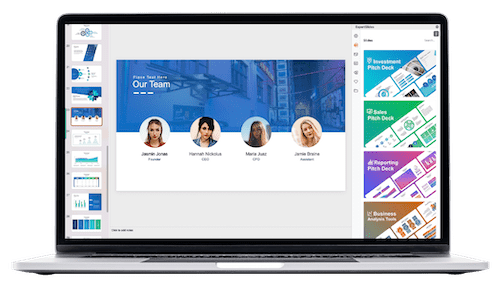What Should I Say to Start a Presentation? Here are 20 Examples
Table of Contents
Ladys and gentlemens esteemed guest and valued colleague welcome. Today we embarks on a journey for exploring discovering and insights.
We get together here on the edge of learning and new ideas I feels proud to be standing in front you for giving thoughts that really matches with progress’s heart. In the next time we spends, we digs into a place where lots can happen and difficulties turns into chances.
The presentation we got here ain’t just simple talk; it be a proof of us all chasing after being top-notch. With minds ready and spirits keen let’s get going on this smart adventure together tied up by the wondering and driven with big dreams.
What is a Presentation Introduction?

We gonna look at some specific cases but first let them gets a grip on what a presentation introduction be and its significance. Presentation introduction—it be the start of a speech or chat, made to grab peoples attention and give the vibe for what’s coming in the rest of it.
Consider it like a invite to your audience interested inviting them for join you on a adventure and its you job to make that invite appealing and captivating as much possible.
A impactful beginning really grabs the listener’s attentions creates a connection and make them look forward to the rest. It also helps you seem like an expert about what you’re talking on. You’ll get to all those important numbers facts and stuff after but starting strong is key for nailing your presentation. When you nail that start it can actually help chill out your jitters and make feel more sure of yourself when you’re up there talking.
How to Start a Presentation

Begin by using catchy phrases or a question for grabbing the attention of people listen to you. Sharing personal stories quotes or surprising numbers might be a real strong beginning too. Build up your trustworthiness and prepare folks for what they going to hear in your talk intro. Stick with this method when kicking off a talk for make an impression:
Tell your audience who you are:
Hello my name is, I’m work as a job and have experience in field that make me know things good for the topic. You listen cause my past work show I knows what talking about which makes folks like you want to hear more of what’s said by me.
Hi all me called [Name] and I has worked on [topic] since a decade. My special knowledge in [specific area related to topic] letted me to collect important understanding on our subject today.
Grab their attention:
Begin your talk with a strong remark or query that instantly captures the listeners interest and make them eager for listening closer. Maybe it’s an unexpected fact, a curious saying, or a question that makes you think hard about the subject matter. Inside templates of PowerPoint presentation you could put pictures to kickoff your presentation with visuals that packs a punch.
Know that [insert statistic]? You consider what this mean for we talk about on [topic] now.
Share what you are presenting:
Tell them what they gonna get from your talk and why it’s worth their time. It build the mood for everything else you say and make they see how it relevant to themselve. Give them a sneak peek of what you’ll cover so they can keep up and pay attention.
Today me shares the newest studies on [topic] and give practical ways for you to use this discoveries in they work. Now you know just what to anticipate let’s jump straight into it!
Use a personal anecdote:
When you shares a personal story or experience about the topic it can make a good connection with your audience and build a friendly relationship. It bring human touch to your talk and makes it feels more like real-life. Just ensure that your small tale fits in with what you trying to say in overall presentation and isn’t overly private or just about yourself.
Right before we start he wants to tell a tale regarding how [topic] have changed him life personally. This story really make them realize how critical the [main point of presentation] is and I hopes it inspire you just as much.
Start with a quote:
An apt quote often acts as a strong opener to you presentation it bring an air of expertise and insightfulness to what you’re saying. Make sure that quotation is related and back up the chief parts of your talk. A good saying can let you stress on the vital subjects in you’re presentation most clearly.
He famous person once were said quote related to topic. Them words sticked with me along all my career I thinks it’s real important for what we gonna talk about today.
State the purpose of your presentation:
Start off by stating clearly the main takeaways you want your audience to get from you talk. It help them pay attention to the important stuff and give them a clear path for the rest they sit through. Lets be real, no one enjoy sitting in on a talk what don’t have no definite goal or way forward.
Example: “Mine goal for today presentation is to give you strategies that helps improve your [related topic]. By the ending I hopes you feels inspired and empowered for making positive change in their own work.”
Use a hook to create intrigue:
A hook it be a statement or question what make people curious and build up excitement for stuff that’s gonna happen. It supposed to get folks wanting to hear more to figure out the rest. Like snagging they focus, this might be some shock fact, weird tale or maybe showing them something cool.
Example: “Imagine having the power to [related topic]. Today, I will share with you some surprising insights and techniques that will help you do just that.”
Remember to choose an opener that aligns with your presentation style and resonates with your audience. With these tips, you can confidently start any presentation on a high note. Now, let’s dive into the meat of our discussion.
20 Examples of Presentation Introductions
Here go 20 ways you can kicks off your presentation making a splash without no more waiting:
Hello morning/afternoon/evening all! Me is honoured to be here this day.
Thanks for be with I today. Me can’t wait to telling you all their thoughts.
Hello all peoples. Is yous ready for exploring new territories and to challenge the normal ways?
Hi there he is glad to see all the smart thinkers, people who invent stuff, and folks with big ideas.
Hello Today we starts a journey of discovering and growing together.
Me feels honored for standing in front of this respected crowd now.
Hello, lady and gentlemans, welcome to these talk on topic.
Hi thanks for come along me on the mission to find understanding and wisdom.
Really nice see lots same faces in crowd this day.
Hello team us need to dive deep into the middle of our subject keeping our minds open and questions ready.
Me is super excited to be here today sharing mine enthusiasm for [topic] with everyone of you.
Hello morning or afternoon or night, respected peoples and important friend. Is a honour for us to having you here.
Hello to this group where we explore the very latest of [topic].
Me feel thankful for get chance for talk about mine own thoughts and ideas with so honorable crowd.
Thanks for being here today. I promises it gunna be worth you time.
Hello friends who make difference! We should be firing up we’re thinking with new ways of seeing things and brave thoughts.
Hello all of us today we challenges the normal way of thinking and push boundaries for innovation.
“Being here today is a total joy surrounded by so many clever heads.”
Hi and you all welcome to this meet-up for thinkers that rocks the boat game-changers and them who shake things up.
Thanks for coming along with me on these trip of discovery and getting wiser.
Harnessing the Power of Visual Aids in Your Opening Speech
Pictures, moving pictures and graphs acts like a strong way for hold your listeners attention and give punch to them opening talk. They helps in forming a picture story of the message you tries to deliver making it stick better for you audience.
But remember use pictures and stuff like that clever some but not too much because you want them to make your talk better not worse. Here’s some ways for put visual aids in your first speech:
Choose relevant and high-quality visuals:
Make sure them pictures and videos you uses is closely connected to your topic and improves the message you trying to send. Visuals that’s low-resolution or not on point can distract peoples and reduce the impact your presentation have.
Always make sure you uses visuals that is clear and simple for understanding since it help your audience keeping their attention and stay focusing on what message you are saying.
Use visuals sparingly:
Don’t flood the audience with lots of visual aids it get them visually and mentally tired. Better to pick just a couple important visuals that makes the biggest difference and use them smart in your talk.
Pictures supposed to make your talk better but they not take over. Ensure you still depend on the words you saying for get across the big ideas in your talk.
Incorporate interactive elements:
Think about utilising engaging components like poll and quiz for getting your audiences involvement; it makes them more part of what you’re presenting. This might also helps in breaking up the dullness typical presentations got and keeps your starting talk rememberable.
Also if you include stuff like letting the audience join in or doing things with their hands it can make your talk more lively and interesting.
Use visuals to tell a story:
Visual aid is very strong for tell stories, more so when you use them with personal story or example. It make an emotional bond with the audience and it make your message feel closer to home. Also if you put in a story form people remember what you say better and get it clearer.
Practice and test your visuals beforehand:
Ensure you practice with your visual aids before they actual presentations to makes sure things goes smoothly. Testing them in the room where you will be presenting because lighting and screen size can affects how it appears is also helpful.
To make a big impact on people when you first start talking, use pictures and other stuff to help show what you mean. They remembers it real good because seeing something is like hearing loads of words!
Tell Your Audience Why They Should be Listening to You

As a presenter, it is important to establish your credibility and give your audience a reason to listen to you. This helps build trust with your audience and sets the tone for the rest of your presentation. Here are some ways to establish your authority and expertise in your opening speech:
Share relevant accomplishments: If you have any notable achievements or experiences related to your topic, share them with your audience. This helps establish your expertise and gives credibility to the information you are presenting.
Mention relevant qualifications: If you have any certifications or degrees related to your topic, mention them in your introduction. This can also help establish your authority and show that you have studied and are knowledgeable about the subject.
Share personal experiences: If you have a personal connection to your topic, such as a success story or lesson learned, share it with your audience. This adds an element of authenticity and helps build a rapport with your audience.
Use social proof: Social proof refers to using evidence of others’ experiences or opinions to support your claims. For example, you can mention statistics or quotes from experts in your field to add credibility to your presentation.
By establishing your authority and expertise in the opening of your speech, you can grab your audience’s attention and make them more receptive to the information you are about to share.
What Concerns or Issues Are You Addressing in Your Presentation?
Another important aspect of a strong opening speech is addressing the concerns or issues that your audience may have regarding your topic. This not only helps establish the relevance and importance of your presentation but also shows that you understand and empathize with your audience’s perspective. Here are some ways to address concerns or issues in your opening speech:
State the problem: Start off by stating the issue or concern that you will be addressing in your presentation. This immediately grabs the attention of your audience and makes them curious to hear more.
Explain why it matters: Take a few moments to explain why the problem is important and how it affects your audience. This helps create a sense of urgency and shows that your presentation has real-world relevance.
Acknowledge different viewpoints: It is important to acknowledge any opposing key points or concerns your audience may have. This shows that you are open-minded and willing to address different perspectives, making your presentation more inclusive.
By addressing concerns and issues in your opening speech, you can create a connection with your audience and show them that you understand their perspective.
Some Additional Tips for a Strong Opening Speech
Start with a strong hook: Just like in writing, the first few lines of your presentation are crucial. Start with an attention-grabbing statement or question to immediately engage your audience.
Keep it concise and focused: Avoid rambling or going off-topic in your opening speech. Keep it short and to the point, focusing on the main purpose of your presentation.
Use humor (if appropriate): Incorporating humor can help make your presentation more engaging and memorable. However, make sure it is appropriate for the audience and topic at hand.
Be confident: Your body language, tone of voice, and overall demeanor greatly influence how your audience perceives you. Make sure to exude confidence and enthusiasm in your opening speech, as it sets the tone for the rest of your presentation.
Be authentic: Ultimately, the key to a strong opening speech is being yourself. Let your personality shine through and connect with your audience genuinely.
FAQs
How can I capture my audience’s interest with the opening line of my presentation?
To captivate your audience from the start, consider using an engaging opening line that poses a thought-provoking question or presents a surprising fact related to your core message. This approach not only piques curiosity but also sets the tone for the entire presentation. For non-native speakers, simple yet impactful questions or statements can be very effective, while native speakers might opt for more complex language nuances.
What should I mention in the first few words of my presentation to ensure it’s relevant and interesting?
In the first few words, it’s crucial to directly relate to your audience’s interests or challenges. Mentioning a story related to your topic can create a personal connection, making your presentation more relatable and engaging. Further detail can be provided as you progress, but those initial words should clearly indicate the value and relevance of your presentation to the audience.
How can I smoothly transition into the main content of my presentation after the opening lines?
After your compelling opening lines, transition into the main content by briefly outlining what will be covered. A useful phrases to bridge this gap could be, “As mentioned earlier, our first point concerns…” This not only signals a shift in focus but also helps in structuring your presentation logically, guiding your audience through the journey you’ve planned for them.
Can I use visuals early in my presentation to maintain interest?
Absolutely! Incorporating a relevant image or infographic right after your opening can visually emphasize your core message and keep the audience engaged. It’s an effective way to present all the relevant statistics or highlight key main points without overwhelming your audience with text. Visuals are especially helpful for both native and non-native speakers as they transcend language barriers and add further detail to your spoken words.
Conclusion
As our journey together comes to a close, I am grateful for the opportunity to share these moments of discovery with each of you. Our exploration today has illuminated pathways to understanding, sparked new ideas, and perhaps even challenged preconceptions. As we prepare to depart, let us carry forth the insights gained here, allowing them to guide our actions and decisions in the days ahead.
Remember, true progress is not measured solely by the breadth of our knowledge but by the depth of our commitment to apply it for the betterment of all. So, let us move forward with purpose and conviction, knowing that the seeds of change we sow today will blossom into a brighter tomorrow. Thank you for your engagement, your passion, and your dedication to making a difference.
Related Blogs
Get 7+ Mio. PowerPoint Assets - FREE SIGN-UP

Sign up for free to our PowerPoint extension, ExpertSlides. Everything you need, directly in PowerPoint. No credit card required.
Related Posts
